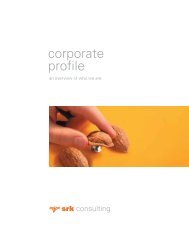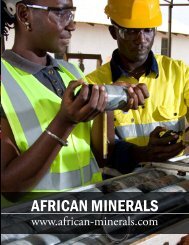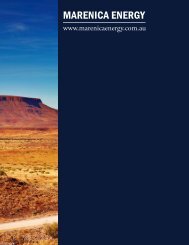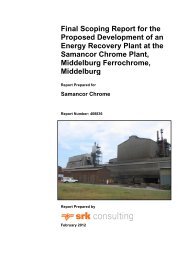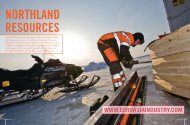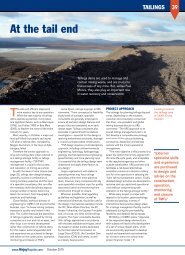Draft Status Quo Report for the Pixley Ka Seme ... - SRK Consulting
Draft Status Quo Report for the Pixley Ka Seme ... - SRK Consulting
Draft Status Quo Report for the Pixley Ka Seme ... - SRK Consulting
You also want an ePaper? Increase the reach of your titles
YUMPU automatically turns print PDFs into web optimized ePapers that Google loves.
<strong>SRK</strong> <strong>Consulting</strong> in association with BKS<br />
<strong>Pixley</strong> <strong>Ka</strong> <strong>Seme</strong> Local Municipality EMF – <strong>Draft</strong> <strong>Status</strong> <strong>Quo</strong> <strong>Report</strong> Page 63<br />
Asset Opportunity Constraint / Threat<br />
utilized and preserved.<br />
Historical towns<br />
Cultural heritage<br />
sites (e.g. historic<br />
buildings,<br />
cemeteries and<br />
memorials)<br />
The rich history of towns in <strong>the</strong> area af<strong>for</strong>ds an<br />
opportunity to expand <strong>the</strong> tourism activities in<br />
<strong>the</strong> PKSLM area.<br />
There are research opportunities <strong>for</strong> local<br />
historians and school children.<br />
Opportunity to expand <strong>the</strong> tourism product in<br />
<strong>the</strong> PKSLM area in a way that does not result<br />
in <strong>the</strong> damage and/or destruction of <strong>the</strong>se<br />
sites.<br />
There is limited or no documentation of <strong>the</strong><br />
history in rural areas. This makes it more<br />
difficult to identify places and sites of cultural<br />
significance that occur in <strong>the</strong>se areas.<br />
Limited focus on <strong>the</strong> preservation of cultural<br />
heritage in towns in <strong>the</strong> PKSLM area. Most of<br />
<strong>the</strong>se sites are in a poor state of repair.<br />
SAHRA database of heritage sites does not<br />
include all sites of cultural significance.<br />
There is little or no in<strong>for</strong>mation regarding <strong>the</strong><br />
location of sites, which means that it is difficult<br />
to determine whe<strong>the</strong>r <strong>the</strong> status of sites.<br />
Limits <strong>the</strong> opportunity to develop some of <strong>the</strong><br />
sites as part of <strong>the</strong> tourism industry.<br />
Some of <strong>the</strong> sites are located on private land<br />
which makes it difficult to access and monitor<br />
<strong>the</strong>ir conservation.<br />
Source: Adapted from Van Vollenhoven (2010)<br />
Table 4-8: Assets, opportunities and constraints/threats associated with resource economics<br />
Asset Opportunity Constraint / Threat<br />
Sustainable<br />
economy<br />
Intact ecosystems<br />
The opportunity to establish a diversified,<br />
robust and sustainable economy that achieves<br />
a balance between <strong>the</strong> maintenance of natural<br />
capital and its use in agriculture, mining,<br />
tourism and <strong>for</strong>estry.<br />
Presence of tourism assets particularly around<br />
Wakkerstroom and in <strong>the</strong> <strong>for</strong>m of heritage<br />
resources. The PGDS has set ambition goals<br />
and targets to improve <strong>the</strong> economic<br />
per<strong>for</strong>mance of tourism in recognition of its<br />
potential to deliver significant long term<br />
benefits. The target is to increase its<br />
contribution to Gross Domestic Product by<br />
10% per annum (MTPA, 2007).<br />
Relatively low level of degradation as yet in<br />
many parts of <strong>the</strong> study area resulting in<br />
economic benefits from ecosystem services<br />
that can be sustained at relatively minimal<br />
cost.<br />
The opportunity to remain a critical area <strong>for</strong><br />
<strong>the</strong> maintenance of water security in <strong>the</strong><br />
region and fur<strong>the</strong>r afield in South Africa.<br />
The opportunity to optimise <strong>the</strong> chances of<br />
being able to adapt to climate change (intact<br />
unfragmented and well-functioning<br />
ecosystems with adequate natural areas are<br />
more resilient to change and offer more<br />
opportunities <strong>for</strong> species movements and<br />
dispersal, a factor that will become<br />
increasingly important in <strong>the</strong> face of climate<br />
changes.<br />
Ecosystem services provision from areas<br />
Level of economic need can result in skewed<br />
focus on short term gains at <strong>the</strong> cost of longer<br />
term sustainable economic development. This<br />
can result in ‘quick fixes’ that are likely to be to<br />
<strong>the</strong> detriment of long term development.<br />
Low levels of awareness of <strong>the</strong> economic<br />
benefits associated with healthy environments<br />
tend to create a bias towards potentially<br />
unsustainable development.<br />
Careful consideration will have to be given <strong>the</strong><br />
preservation of <strong>the</strong> assets upon which tourism<br />
growth relies.<br />
Tourism development seems constrained by a<br />
lack of resources and limited institutional<br />
capacity at a local and regional level. To this<br />
can be added a lack of a clear tourism<br />
strategy and dedicated tourism staff <strong>for</strong><br />
PKSLM.<br />
The threat of serious ecological impacts in<br />
which <strong>the</strong> natural capital of <strong>the</strong> area is<br />
damaged to <strong>the</strong> point where it is no longer<br />
adaptable and no longer delivers economic<br />
benefits and can only be repaired at great<br />
cost, if at all. Exceeding environmental<br />
thresholds and having to pay a heavy price <strong>for</strong><br />
rehabilitation and restoration of critical<br />
ecological functions.<br />
Pressure to allow coal mining and o<strong>the</strong>r land<br />
conversion in particularly sensitive areas<br />
containing significant natural capital.<br />
Allowing alien invasive plants to spread<br />
<strong>the</strong>reby threatening indigenous vegetation and<br />
water security.<br />
Low absorptive capacity of sensitive area such<br />
as <strong>the</strong> Wakkerstroom wetlands.<br />
Claims that mitigation of mining impacts is<br />
KILI/BEAT G:\404946_PIXLEY EMF\7REPORTS\<strong>Status</strong> <strong>Quo</strong> report\<strong>Draft</strong> report\<strong>Draft</strong> status quo report, July 2010.docx July 2010



